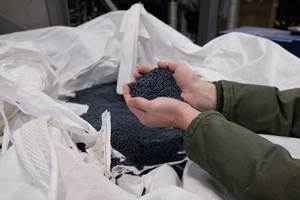SABIC & Partners Collaborate to Produce 'Revolutionary' Thermoplastic Composite Vehicle Panel
Cost-effective and lightweight vehicle panels produced using SABIC’s Udmax tape in a one-shot compression molding process challenges panels made of metal or thermosets.
At JEC World 2019, SABIC unveiled a new technology for producing lightweight, cost-effective and recyclable vehicle panels using its Udmax tape—a unidirectional, fiber-reinforced thermoplastic composite. This ‘revolutionary’ technology, which is designed to replace traditional panels made of metal and thermoset materials for interior and exterior automotive applications, will soon be commercialized in the bulkhead of a light commercial vehicle (LCV) produced in large scale for the global automotive market.
The bulkhead’s development resulted from a collaborative effort between SABIC, U.K.-based engineering services provider RLE International, Italian toolmaker AMA Composites, and German weaver Setex Textiles. Vehicle panels that incorporate Udmax tape within the structure have been shown to combine strength and impact resistance with light weight, which can result in mass reduction of interior panels of up to 35% in comparison to metal parts. In case of exterior panels, the composite material can help reduce mass up to 50%. They are produced using a highly efficient, one-shot process of lamination and low-pressure (one-shot compression) molding.
A proprietary lamination featuring a core of extra-wide Udmax tape woven by Setex incorporates aesthetic finish. A SABIC source noted that there are actually seven basic layers in this bulkhead’s material formulation. “In the middle our Udmax GPP 45-70 was used in a fabric form. The Udmax weave does the ‘structural’ work. On both sides, there was Azdel—an ultralight material based on PP/PET scrim, and on one side (drivers side) a nice grey fabric. At the cargo site a chosen black fabric.” The process also allows for varying the thickness of the panel in order to improve noise, vibration and harshness (NVH) levels, helping to reduce noise in the vehicle. AMA Composites created the tool and molded the concept parts.
Importantly, the mass saving in such a vehicle panel can be achieved without sacrificing the impact performance of the part. According to RLE International, the bulkhead complies with ISO 27956—the standard for securing cargo in delivery LCVs. The build-up of the process and the tensile strength of the Udmax are the main factors in optimizing the impact resistance of the bulkhead. Moreover, the new method—designed, developed and engineered by RLE International—can reduce tool costs by up to 80% compared to injection molding tools for a conventional, multi-piece bulkhead. Overall, the supplied cost of the LCV’s bulkhead can be 10% lower than the conventional metallic bulkhead that it replaces. In addition, with molding cycle times of under 2 min., this streamlined process avoids sourcing and assembling multiple components, traditionally at different supplier locations, as well as secondary painting and trim operations.
“Our new technology for producing panels using Udmax thermoplastic composite tape offers tremendous opportunities to the automotive industry. One example is the electric vehicle sector, where lower panel weight can extend driving range and lower-cost tooling can reduce capital investments for start-up companies,” said Mark Grix, head of interior & exterior engineering for RLE International.
Said Hans Warmerdam, CEO and chief sales & marketing officer for SABIC FRT—a SABIC affiliate—“We’re confident that the light commercial vehicle’s bulkhead is the first of many structural applications where our innovative materials, combined with this novel processing approach, can help solve our customers’ challenges of achieving lighter weight without compromising safety, durability and fuel or energy use. Through continued collaboration among this unique team of engineers, designers and technical experts in materials and in conversion processes, we intend to explore more ways to expand the adoption of our thermoplastic composite technology.”
Related Content
Polyethylene Fundamentals – Part 4: Failed HDPE Case Study
Injection molders of small fuel tanks learned the hard way that a very small difference in density — 0.6% — could make a large difference in PE stress-crack resistance.
Read MoreDelivering Increased Benefits to Greenhouse Films
Baystar's Borstar technology is helping customers deliver better, more reliable production methods to greenhouse agriculture.
Read MoreNew Facility Refreshes Post-Consumer PP by Washing Out Additives, Contaminants
PureCycle prepares to scale up its novel solvent recycling approach as new facility nears completion.
Read MoreCommodity Resin Prices Flat to Lower
Major price correction looms for PP, and lower prices are projected for PE, PS, PVC and PET.
Read MoreRead Next
Lead the Conversation, Change the Conversation
Coverage of single-use plastics can be both misleading and demoralizing. Here are 10 tips for changing the perception of the plastics industry at your company and in your community.
Read MorePeople 4.0 – How to Get Buy-In from Your Staff for Industry 4.0 Systems
Implementing a production monitoring system as the foundation of a ‘smart factory’ is about integrating people with new technology as much as it is about integrating machines and computers. Here are tips from a company that has gone through the process.
Read More
























